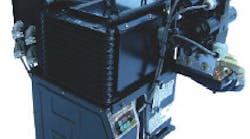In the 1990s, Japan passed legislation challenging its industry to reduce energy consumption — or face stiff tax penalties. Companies had to reduce energy consumption by a specified amount each year for a certain period of time. To meet these goals, much of the country’s industry — particularly machine-tool builders — took along look at hydraulics. A typical hydraulic system uses a constant
speed motor tha operates at about 1800 rpm. During idle periods, the electric motor continues to rotate at full speed, perhaps consuming 30-45% of full load amperage.
Enter inverter-based hydraulic pumps. In essence, the inverter causes the system to pump only as much as it needs to maintain constant pressure. Many machine-tool manufacturers use inverter-based hydraulic pumps on some of their new models. Overall, the technology has taken Japan by storm, particularly within the machine-tool industry, where about a third of the equipment being built uses some version of the technology.
How it works
The pump’s operation is relatively simple. It makes use of a switch-reluctance motor. For higher pressure applications, such as clamping, the unit uses a motor system similar to a frequency inverter, with a low-inertia, high-torque design.
A closed-loop-feedback from an encoder behind the motor monitors the motor’s position and rotation speed. A pressure transducer measures the pressure of fluid and calculates the flow volume of the pump. The system fires electrical pulses, the rate of which controls the motor to turn at a specific speed.
The unit’s inverter technology attempts to maintain a specified pressure. The inverter slows the motor down to 400 rpm to maintain line pressure — but as soon as a valve shifts downstream, the pressure transducer detects the pressure drop, and the inverter ramps the motor speed up in less than 0.1 sec to maintain the specified pressure.
In essence, the pump’s inverter technology saves energy by keeping line pressure constant. Because the motor isn’t always running at a constant speed, the system generates less heat. Less pressurized oil is released back to the tank, so the pump uses one-third the oil of traditional pumps; and because the process is cooler overall, the tank — and the entire unit — can be smaller (usually, half the size of conventional units with less environmental waste oil to be changed when serviced).
System smarts
The pump’s pressure transducer and encoder also bring some self-monitoring capabilities into the fray. The closed-loop feedback between the transducer and encoder means the pump knows the speed of the motor rotation along with the machine’s flow-rate discharge. If the hydraulic system springs a leak, or has some internal problems, the pump can sense the subsequent change.
Cost vs energy consumption
Studies performed on small operations show that the technology drops overall plant power consumption by between 10-15%. That reduction not only could affect a company’s operating costs — but also the local power grids. In Ontario, for example, industry has been consuming up to 80% of energy within the area’s infrastructure. A 10% drop in energy coinsumption could make a huge impact.
Though inverter-based pumps have taken off in Japan, the technology has yet to see widespread adoption in the U.S. With most government programs on energy savings focused on consumer products — dryers, air conditioners, and the like — incentive for industry to reduce energy consumption has been limited.
At least one company is doing on its own. Honda, as part of “Green Factory Initiative,” is testing the performance of inverterbased hydraulic pumps on a variety of industrial equipment in Anna Engine Plant and Russels Point facility in Ohio. During tests, the company saw power consumption for most machines drop between 45-50%.
Going the way of the hybrid
In the future, pump technology may go the same way as the hybrid car. Today, the market for inverter-based pumps has come mainly from shops seeking replacement units for their older machinery. But cost for replacing working units is still a barrier. The product pays for itself in a year and a half to two years — a little long for many who seek payback in 12 months or less. However, these complete hydraulic power units can somtimes be sold at about the cost of a replacement hydraulic pump; so the units have seen significant sales success as a replacement option on downed machinery.
Just as you don’t yet see hybrid cars on every street corner, largescale adoption of inverter pump technology, like that of Honda’s, is still in its infancy. Cost is still number one above energy savings in U.S. industry. However, with fuel prices and other energy costs on the rise, inverter-based hydraulic pumps may find more homes on factory floors in America in the years to come.
Contact All World Machinery Supply at 815-943-9111 or visit www.allworldmachinery.com


